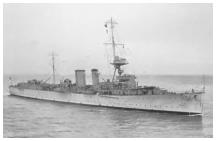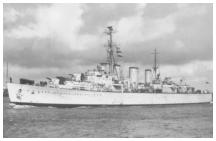




Pages




Minotaur Class
(1908)
Technical Details:
Displacement: 14,600 tons
Dimensions: Length 519 ft,
Beam 75 ft. Draught: 26 ft
Machinery: Triple Expansion engines
developing 27,000 shp, Two shafts
Performance: Maximum speed 23 knots,
Range 8,150 nautical miles
Armour: 3 - 6 inch belt, 6 inch barbettes,
8 inch turrets, ½ - 1½ inch decks
Armament: 4 x 9.2 inch, 10 x 7.5 inch,
16 x 12 pounder guns + smaller,
5 x 18 inch torpedo tubes
Complement: 755






Pages


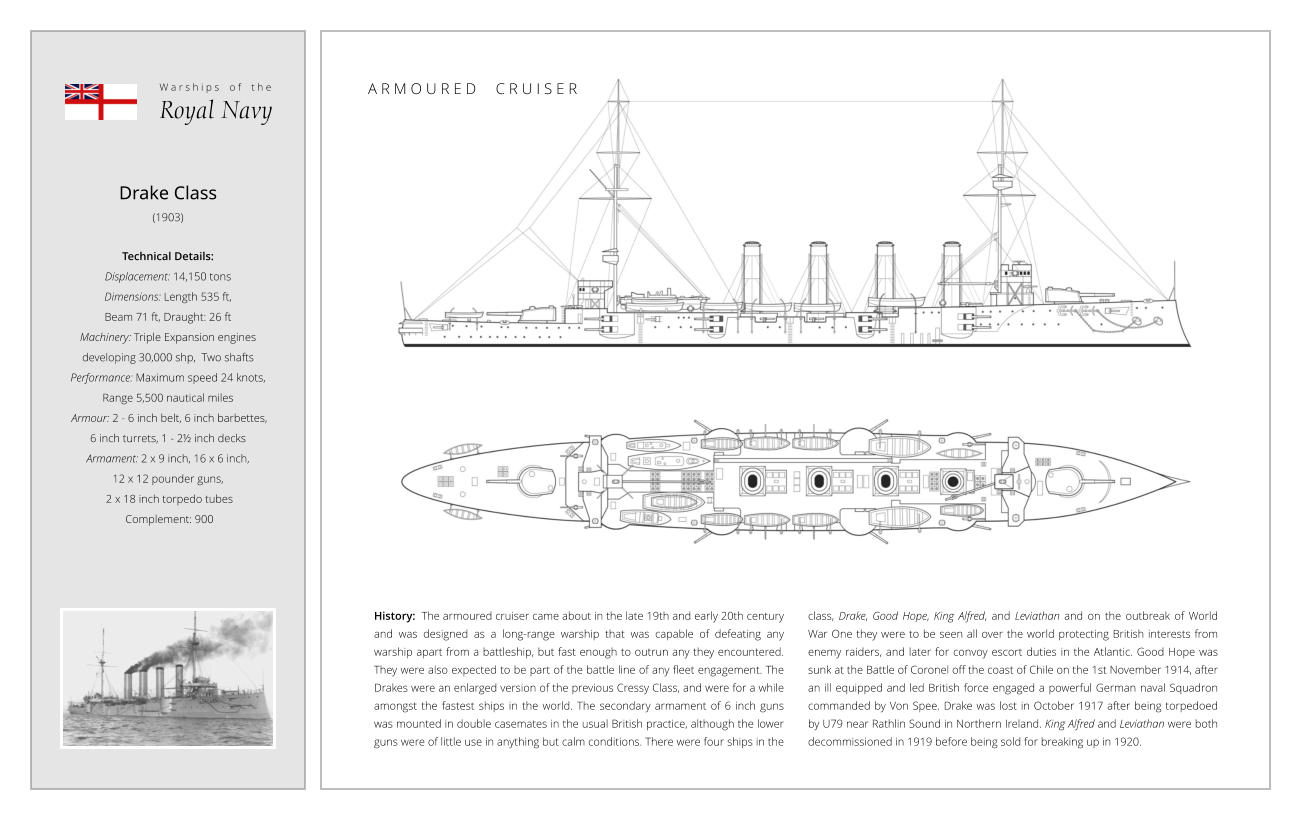
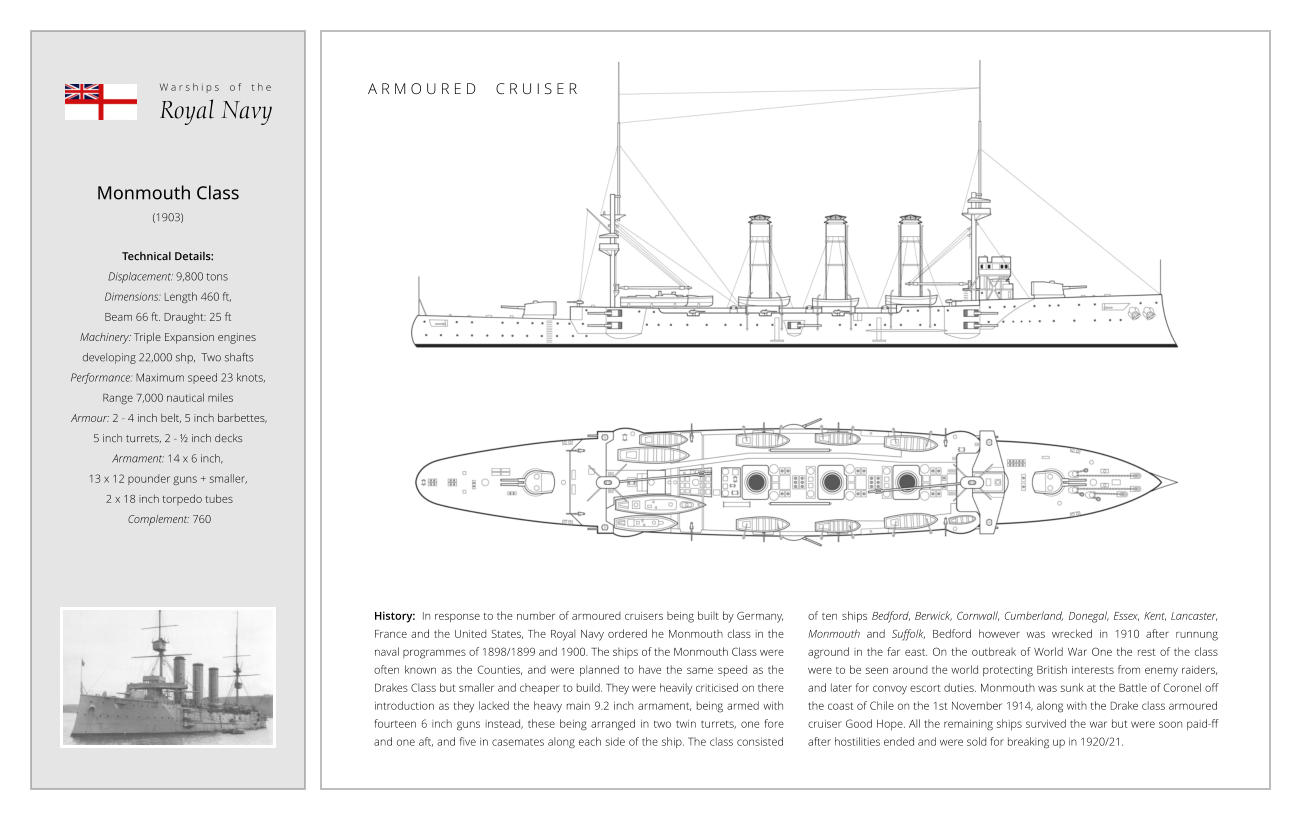
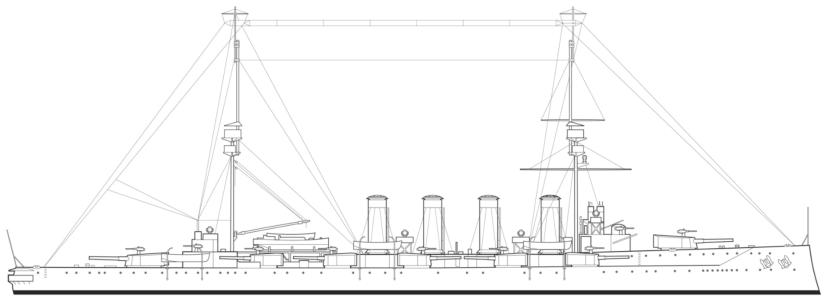

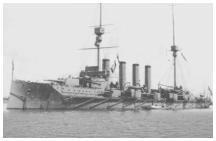
A R M O U R E D C R U I S E R
Hawkins Class
(1919)
Technical Details:
Displacement: 9,750 tons
Dimensions: Length 605 ft,
Beam 58 ft, Draught: 17 ft 3 ins
Machinery: Geared turbines
developing 70,000 shp, Four shafts
Performance: Maximum speed: 31 knots,
Range 6,200 nautical miles
Armour: 1½ - 3 inch belt,
1½ inch bulkheads, 1½ inch decks,
2 inch gunshields, 2 inch magazines
Armament: 7 x 7.5 inch, 4 x 4 inch guns,
4 x 3 inch AA guns, 2 x 2 pdr pom poms,
6 x 21 inch torpedo tubes
Complement: 712


H E A V Y C R U I S E R


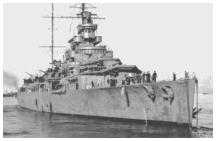
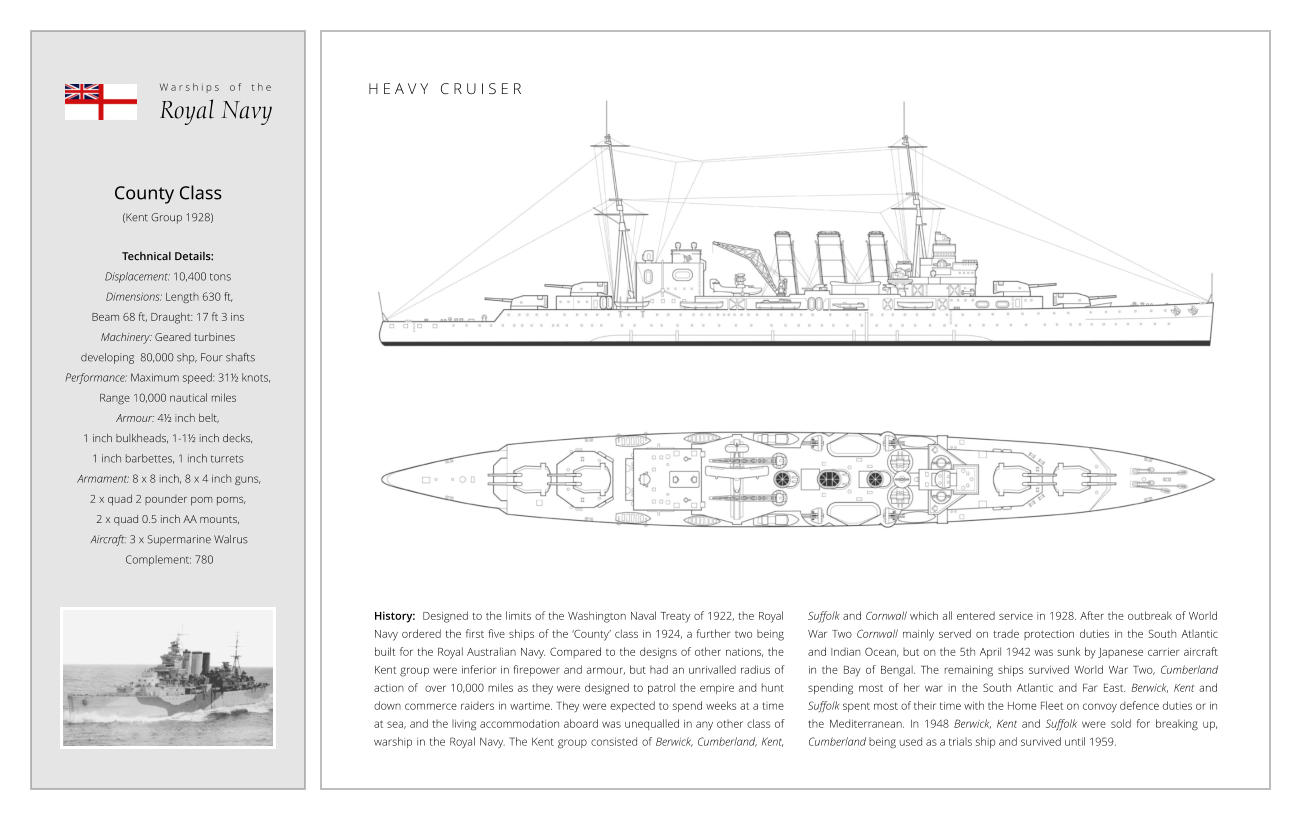
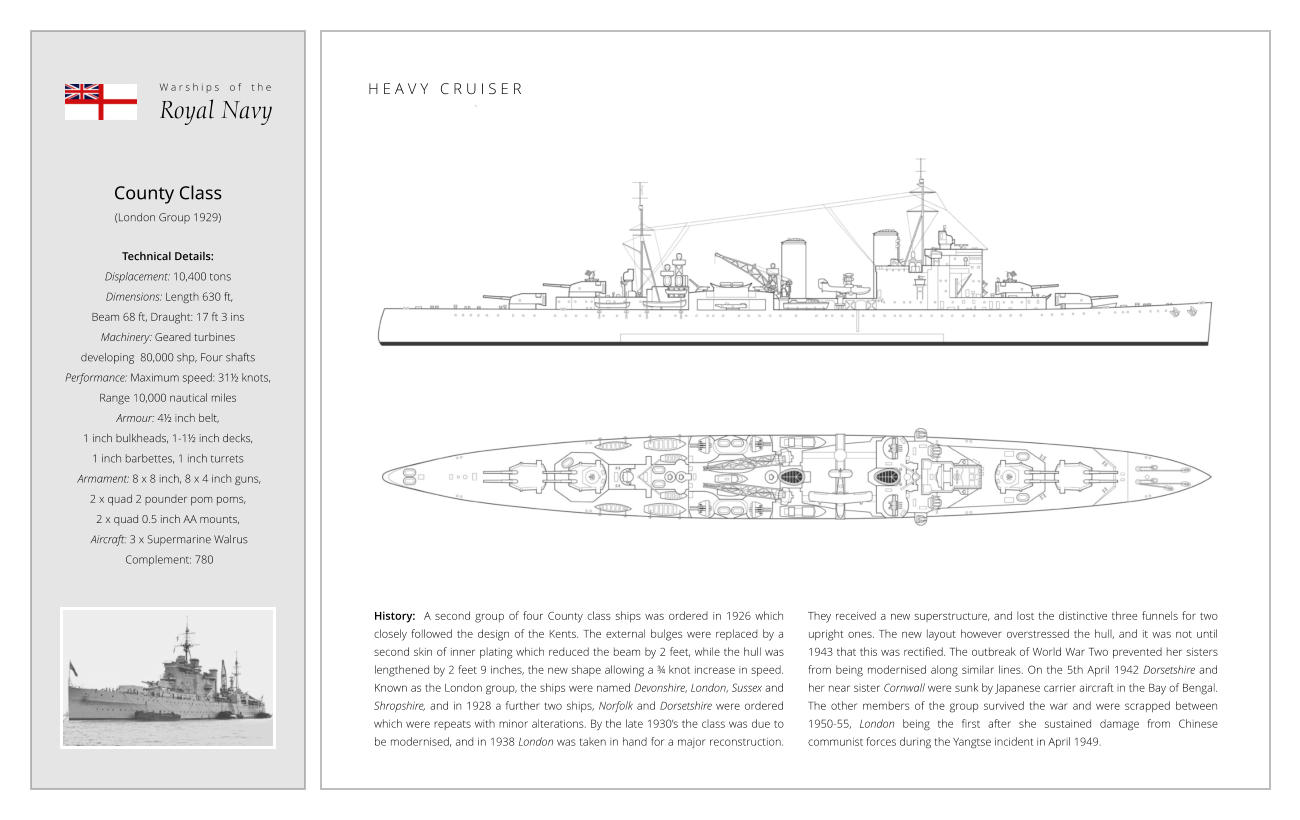
York Class
(1930)
Technical Details:
Displacement: 8,250 tons
Dimensions: Length 575 ft,
Beam 57 ft, Draught: 17 ft
Machinery: Geared turbines
developing 80,000 shp, Four shafts
Performance: Maximum speed: 32¼ knots,
Range 6,100 nautical miles
Armour: 3 inch belt, 1½ inch decks,
1 inch turrets, 1- 4 inch magazine
Armament: 6 x 8 inch, 8 x 4 inch guns,
2 x quadruple 2 pounder pom poms,
2 x quadruple 0.5 inch machine guns,
2 x triple 21 in torpedo tubes
Aircraft Carried: 1 x Fairey Seafox
Complement: 623


H E A V Y C R U I S E R


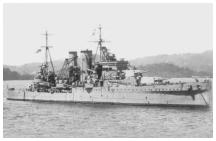
‘C’ Class
(Caledon Group 1917)
Technical Details:
Displacement: 4,238 tons
Dimensions: Length 450 ft,
Beam 42 ft 3 ins, Draught: 18 ft 9 ins
Machinery: Geared turbines
developing 40,000 shp, Two shafts
Performance: Maximum Speed: 29 knots,
Maximum Range 2,500 miles
Armour: 1¼ - 3 inch belt, 1 inch decks,
6 inch conning tower
Armament: 5 x 6 inch Mk XII guns,
2 x 3 inch high angle AA guns,
8 x 21 inch torpedo tubes
Complement: 438


L I G H T C R U I S E R
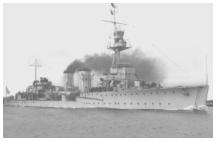


Danae Class
(1918)
Technical Details:
Displacement: 4,650 tons
Dimensions: Length 471 ft,
Beam 46 ft, Draught: 14 ft 6 ins
Machinery: Geared turbines
developing 40,000 shp, Two shafts
Performance: Maximum speed: 29 knots,
Range 2,650 nautical miles
Armour: 1 - 3 inch belt, 1 inch decks
Armament: 6 x 6 inch, 2 x 3 inch HA guns,
8 x 21 inch torpedo tubes
Complement: 344


L I G H T C R U I S E R
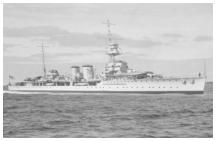


Emerald Class
(1926)
Technical Details:
Displacement: 7,580 tons
Dimensions: Length 570 ft,
Beam 54 ft 6 ins, Draught: 16 ft 6 ins
Machinery: Geared turbines
developing 80,000 shp, Four shafts
Performance: Maximum speed: 33 knots,
Range 9,200 nautical miles
Armour: 1½ - 3 inch belt,
1 inch bulkheads, 1 inch decks,
2 inch gunshields, 2 inch magazines
Armament: 7 x 6 inch, 3 x 4 inch HA guns,
2 x 2 pounder pom poms,
21 inch torpedo tubes,
Aircraft: 1
Complement: 572


L I G H T C R U I S E R


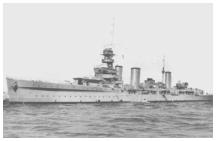
Leander Class
(1931)
Technical Details:
Displacement: 6,980 tons
Dimensions: Length 554 ft,
Beam 55 ft 9 ins, Draught: 16 ft
Machinery: Geared turbines
developing 72,000 shp, Four shafts
Performance: Maximum speed: 32½ knots,
Range 6,600 nautical miles
Armour: 4 inch belt, 1½ inch bulkheads,
1¼ inch decks, 1 inch turrets,
1-3½ inch magazines
Armament: 8 x 6 inch, 8 x 4 inch guns,
3 x quadruple 0.5 inch AA mounts,
2 x quadruple 21 in torpedo tubes
Aircraft: 2 x Fairey Seafox
Complement: 570


L I G H T C R U I S E R


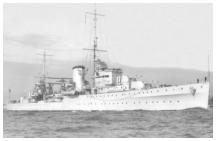
Arethusa Class
(1935)
Technical Details:
Displacement: 5,220 tons
Dimensions: Length 506 ft,
Beam 51 ft, Draught: 14 ft
Machinery: Geared turbines
developing 64,000 shp, Four shafts
Performance: Maximum speed: 32¼ knots,
Range 6,100 nautical miles
Armour: 2¼ inch belt, 1 inch bulkheads,
1 inch decks, 1 inch turrets, 3 inch magazines
Armament: 6 x 6 inch, 8 x 4 inch guns,
2 x quadruple 2 pounder pom poms,
2 x quadruple 0.5 inch machine guns,
2 x triple 21 inch torpedo tubes
Aircraft: 1 x Fairey Seafox
Complement: 500


L I G H T C R U I S E R


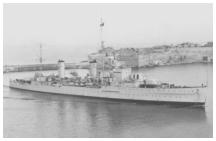
Southampton Class
(1937)
Technical Details:
Displacement: 9,100 tons
Dimensions: Length 591 ft 6 ins,
Beam 61 ft 9 ins, Draught: 17 ft
Machinery: Geared turbines
developing 75,000 shp, Four shafts
Performance: Maximum speed: 32 knots,
Range 6,100 nautical miles
Armour: 4½ inch belt, 2½ inch bulkheads,
1½ inch decks, 1 inch turrets, 4½ inch magazine
Armament: 12 x 6 inch, 8 x 4 inch guns,
2 x quadruple 2 pounder pom poms,
2 x quadruple 0.5 inch machine guns,
2 x triple 21 in torpedo tubes
Aircraft: 2 x Supermarine Walrus
Complement: 750


L I G H T C R U I S E R


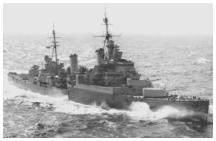
Edinburgh Class
(1939)
Technical Details:
Displacement: 10,260 tons
Dimensions: Length 613 ft 6 ins,
Beam 63 ft 3 ins, Draught: 17 ft 3 ins
Machinery: Geared turbines
developing 80,000 shp, Four shafts
Performance: Maximum speed: 32½ knots,
Range nautical 6,100 miles
Armour: 4½ inch belt, 2½ inch bulkheads,
2 inch decks, 4 inch turrets, 3 inch magazine
Armament: 12 x 6 inch, 12 x 4 inch guns,
4 x quadruple 2 pounder pom poms,
2 x quadruple 0.5 inch AA mounts,
2 x triple 21 in torpedo tubes
Aircraft Carried: 3 x Supermarine Walrus
Complement: 850


L I G H T C R U I S E R


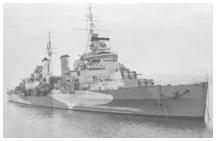
Crown Colony Class
(Fiji Group 1940)
Technical Details:
Displacement: 8,525 tons
Dimensions: Length 555 ft 6 ins,
Beam 62 ft, Draught: 16 ft 6 ins
Machinery: Geared turbines
developing 72,500 shp, Four shafts
Performance: Speed: 31½ knots,
Range 11,600 nautical miles
Armour: 3½ inch belt, 2 inch bulkheads,
2 inch decks, 1 - 2 inch turrets
Armament: 12 x 6 inch, 8 x 4 inch guns,
2 x quadruple 2 pounder pom poms,
4 x quadruple 0.5 inch AA mounts,
2 x triple 21 inch torpedo tubes
Aircraft: 2 x Supermarine Walrus
Complement: 730


L I G H T C R U I S E R


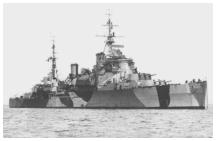
Crown Colony Class
(Ceylon Group 1940)
Technical Details:
Displacement: 8,712 tons
Dimensions: Length 555 ft,
Beam 62 ft, Draught: 17 ft
Machinery: Geared turbines
developing 72,500 shp, Four shafts
Performance: Speed: 33 knots,
Range 10,200 nautical miles
Armour: 3½ inch belt, 2 inch bulkheads,
2 inch decks, 1 - 2 inch turrets
Armament: 9 x 6 inch, 8 x 4 inch guns,
4 x quadruple 2 pounder pom poms,
10 x twin 20 mm Oerlikon guns
2 x triple 21 inch torpedo tubes
Aircraft: None
Complement: 800


L I G H T C R U I S E R


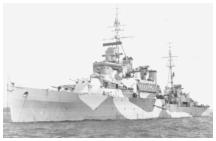
Dido Class
(1940)
Technical Details:
Displacement: 5,600 tons
Dimensions: Length 512 ft,
Beam 50 ft 6 ins, Draught: 14 ft
Machinery: Geared turbines
developing 62,000 shp, Four shafts
Performance: Maximum speed: 32¼ knots,
Range 6,800 nautical miles
Armour: 3 inch belt, 1 inch bulkheads,
1 inch decks, 2 inch magazines
Armament: 10 x 5.5 inch dual purpose guns,
2 x quadruple 2 pounder pom poms
2 x quadruple 0.5 inch AA mounts,
2 x triple 21 in torpedo tubes
Complement: 480


L I G H T C R U I S E R


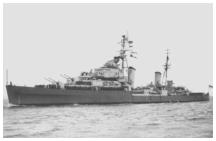
Bellona Class
(1943)
Technical Details:
Displacement: 5,950tons
Dimensions: Length 512 ft,
Beam 50 ft 6 ins, Draught: 15 ft
Machinery: Geared turbines
developing 62,000 shp, Four shafts
Performance: Maximum speed: 32 knots,
Range 6,800 nautical miles
Armour: 3 inch belt, 1 inch bulkheads,
1 inch decks, 2 inch magazines
Armament: 8 x 5.5 inch dual purpose guns,
3 x quadruple 0.5 inch AA mounts,
6 x twin 20 mm AA guns,
2 x triple 21 in torpedo tubes
Complement: 480


L I G H T C R U I S E R
Swiftsure Class
(1945)
Technical Details:
Displacement: 8,885 tons
Dimensions: Length 555 ft 6 ins,
Beam 64 ft, Draught: 17 ft 3 ins
Machinery: Geared turbines
developing 72,500 shp, Four shafts
Performance: Maximum speed: 31½ knots,
Range 9,200 nautical miles
Armour: 3½ inch belt, 2 inch bulkheads,
2 inch decks, 1 - 2 inch turrets
Armament: 9 x 6 inch, 10 x 4 inch guns,
4 x quadruple 2 pounder pom poms,
6 x single 40 mm AA guns,
2 x triple 21 in torpedo tubes
Complement: 867


L I G H T C R U I S E R




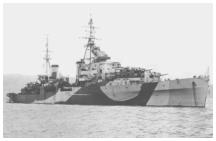
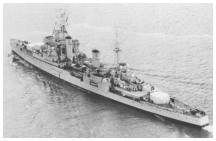
Apollo Class
(1891)
Technical Details:
Displacement: 3,600 tons.
Dimensions: Length 314 ft.
Beam 42 ft 8 ins. Draught: 17 ft 6 ins.
Machinery: Triple Expansion engines
developing 9,000 shp, 2 shafts.
Performance: Maximum Speed 20 knots.
Armour: 4½ inch gun shields, 1 - 2 inch decks.
Armament: 2 x 6 inch, 6 x 4.7 inch,
8 x 6 pounder, 1 x 3 pounder guns,
4 x 14 inch torpedo tubes.
Complement: 273


P R O T E C T E D C R U I S E R
Pelorus Class
(1897)
Technical Details:
Displacement: 2,250 tons.
Dimensions: Length 314 ft,
Beam 36 ft 6 ins. Draught: 16 ft
Machinery: Triple Expansion engines
developing 7,000 shp, 2 shafts
Performance: Maximum Speed 20 knots
Armour: ¼ inch gun shields,
1½ - 2 inch decks.
Armament: 8 x 4 inch,
8 x 3 pounder guns,
2 x 14 inch torpedo tubes
Complement: 224




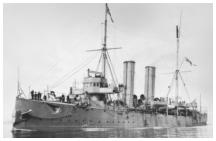
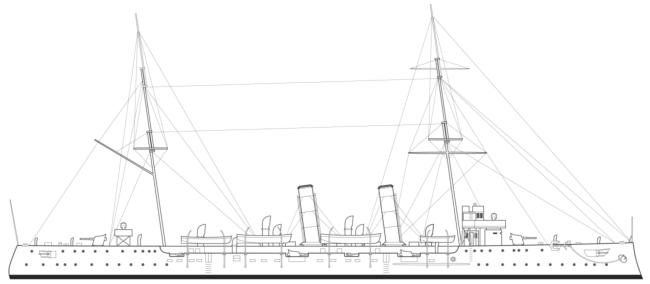

P R O T E C T E D C R U I S E R
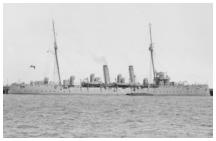
HMS Adventure
(1924)
Technical Details:
Displacement: 6,740 tons
Dimensions: Length 500 ft,
Beam 59 ft, Draught: 14 ft 6 ins
Machinery: Geared turbines
developing 40,000 shp,
Diesel engines rated at 9,200 hp,
Two shafts
Performance: Maximum speed: 27½ knots,
Range 4,500 nautical miles
Armour: None
Armament: 4 x 4.7 inch high angle guns,
4 x 2 pounder pom poms,
2 x quadruple machine guns,
(later 9 x 20 mm guns added)
Complement: 395


M I N E L A Y E R C R U I S E R
Abdiel Class
(1941)
Technical Details:
Displacement: 3,415 tons
Dimensions: Length 400 ft 6 ins,
Beam 40 ft, Draught: 14 ft 9 ins
Machinery: Geared turbines
developing 72,000 shp, Two shafts
Performance: Maximum speed: 40 knots,
Range 1,000 nautical miles
Armour: None
Armament: 8 x 4 inch dual purpose guns,
1 x 2 quadruple 2 pounder pom poms,
2 x quadruple machine guns,
(later 12 x 20 mm guns added)
Mineload: 156
Complement: 245


M I N E L A Y E R C R U I S E R
